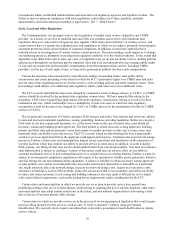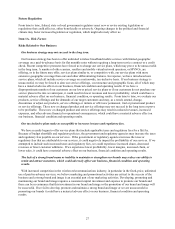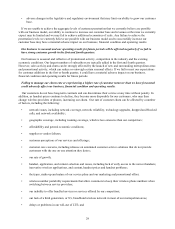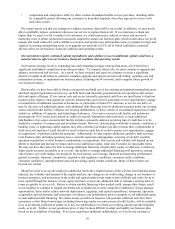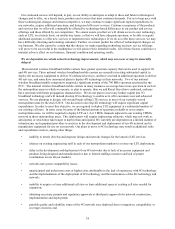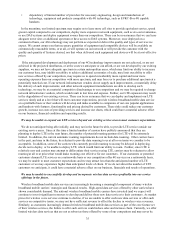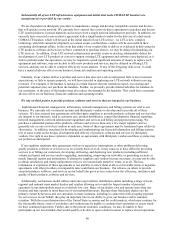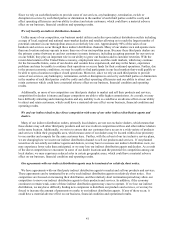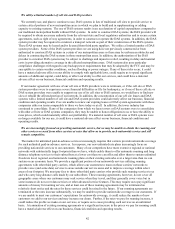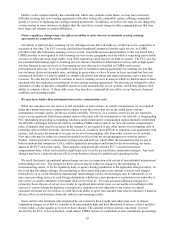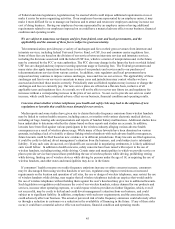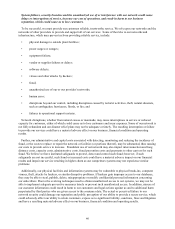Metro PCS 2009 Annual Report Download - page 48
Download and view the complete annual report
Please find page 48 of the 2009 Metro PCS annual report below. You can navigate through the pages in the report by either clicking on the pages listed below, or by using the keyword search tool below to find specific information within the annual report.36
We also have decided to forego any further deployment or development of 3G broadband technology or a 3G
broadband network, in favor of deploying 4G technology, such as LTE. While we anticipate that our LTE network
will have sufficient capacity to meet the anticipated needs of our customers, we have no experience with our
customers’ demands for high-speed data services, the number of customers for such services, or the new services we
plan to launch when we deploy LTE. In order for our LTE deployment to be successful, we will need to design and
implement new data sales and marketing initiatives, including new services to support our deployment of LTE. In
addition, we have not and may not gain access to certain of the proprietary data content available to national
wireless broadband mobile operators. If we are unable in the future to successfully incorporate the most advanced
wireless data services, including certain 4G technologies, into our service offerings or gain access to popular
content, our customer additions and ARPU could decrease and our churn could increase. Studies suggest that, while
the volume of mobile data users will increase exponentially, the profitability of such services will decline or
evaporate. We could experience higher than anticipated usage of our LTE services that could result in performance
of our LTE services not meeting customer expectations. As a result, we may be required to spend additional capital
to increase the capacity of our LTE network or purchase additional spectrum or limit usage by our customers of LTE
services. Since we have limited spectrum in some of our metropolitan areas, we may be unable to meet customer
demand for service, which may lead to us having to limit service in those metropolitan areas. If we are unable to
meet the customer demand for our LTE data services, it could have a material adverse effect on our business,
financial condition and operating results. Furthermore, we rely on third parties to provide us access to most data,
music and video services and access to new handsets to deliver these advanced services. If we are unable to obtain
access to such services, incorporate such services into our service offerings, or purchase handsets, applications,
content or services from third parties, at a reasonable cost and on a timely basis in the future, it could have a material
adverse effect on our business, financial condition and operating results.
We may be unable to acquire additional spectrum in the future at a reasonable cost.
Because we offer unlimited calling services for a fixed rate, our customers tend, on average, to use our services
more than the customers of other wireless broadband mobile carriers. We believe that the average minutes of use of
our customers may continue to rise. We intend to meet this demand by utilizing spectrum-efficient state-of-the-art
technologies, such as six-sector cell site technology, LTE, EVRC-B or 4G handsets and intelligent antennas.
Nevertheless, in the future we may need to acquire additional spectrum in order to maintain our quality of service, to
meet increasing customer demands or to allow the deployment of these technologies. However, we cannot assure
you that additional spectrum will be made available by the FCC on a timely basis, on terms and conditions or under
service rules that we consider to be suitable for our commercial uses, or that we will be able to acquire additional
spectrum at a reasonable cost. In addition, the FCC may impose conditions on the use of new wireless broadband
mobile spectrum, such as heightened build-out requirements or open access requirements that may make it less
attractive to, or less economical for, us. If additional spectrum is unavailable on reasonable terms and conditions
when needed, unavailable at a reasonable cost, or unavailable without conditions that impose significant costs or
restrictions on us, we may not be able to continue to increase our customer base, meet the requirements of our
customers’ usage of our services or to offer new services and as a result we could lose customers or revenues, which
could have a material adverse effect on our business, financial condition, and operating results.
We may undertake mergers, acquisitions or strategic transactions that could result in operating difficulties,
dilution and distraction from our business.
We may in the future expand the markets in which we operate through the acquisition of selected spectrum or
operating markets from other telecommunication service providers, the acquisition of additional spectrum from FCC
auctions or auctions in other countries, the acquisition of other telecommunication service providers or through other
strategic transactions. Any such transactions can entail risk, may require a disproportionate amount of our
management and financial resources, may divert management’s attention, and may create various operating
difficulties and expenditures, among which may include:
• uncertain revenues and expenses, with the result that we may not realize the growth in revenues, anticipated
cost structure, profitability, or return on investment that we expect;
• difficulty integrating the acquired technologies, services, spectrum, products, operations and personnel of
the acquired businesses while maintaining uniform standards, controls, policies and procedures;
• disruption of ongoing business;


